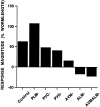A dynamic network simulation of the nematode tap withdrawal circuit: predictions concerning synaptic function using behavioral criteria
- PMID: 8656295
- PMCID: PMC6578605
- DOI: 10.1523/JNEUROSCI.16-12-04017.1996
A dynamic network simulation of the nematode tap withdrawal circuit: predictions concerning synaptic function using behavioral criteria
Abstract
The nematode tap withdrawal reflex demonstrates several forms of behavioral plasticity. Although the neural connectivity that supports this behavior is identified (Integration of mechanosensory stimuli in Caenorhabditis elegans, Wicks and Rankin, 1995, J Neurosci 15:2434-2444), the neurotransmitter phenotypes, and hence whether the synapses in the circuit are excitatory or inhibitory, remain uncharacterized. Here we use a novel strategy to predict the polarity configuration, i.e., the array of excitatory and inhibitory connections, of the nematode tap withdrawal circuit using an anatomically and physiologically justifiable dynamic network simulation of that circuit. The output of the modeled circuit was optimized to the behavior of animals, which possessed circuits altered by surgical ablation by exhaustively enumerating an array of synaptic signs that constituted the modeled circuit. All possible polarity configurations were then compared, and a statistical analysis was used to determine whether, for a given synaptic class, a particular polarity was associated with a good fit to behavioral data. The results from four related experiments were used to predict the polarities of seven of the nine cell classes of the tap withdrawal circuit. In addition, the model was used to assess possible roles for two novel mechanosensory integration neurons: DVA and PVD.
Figures







Similar articles
-
Integration of mechanosensory stimuli in Caenorhabditis elegans.J Neurosci. 1995 Mar;15(3 Pt 2):2434-44. doi: 10.1523/JNEUROSCI.15-03-02434.1995. J Neurosci. 1995. PMID: 7891178 Free PMC article.
-
Behavioral Plasticity in the C. elegans Mechanosensory Circuit.J Neurogenet. 2008;22(3):239-55. doi: 10.1080/01677060802298509. J Neurogenet. 2008. PMID: 19012160 Review.
-
Effects of tap withdrawal response habituation on other withdrawal behaviors: the localization of habituation in the nematode Caenorhabditis elegans.Behav Neurosci. 1997 Apr;111(2):342-53. doi: 10.1037//0735-7044.111.2.342. Behav Neurosci. 1997. PMID: 9106674
-
The integration of antagonistic reflexes revealed by laser ablation of identified neurons determines habituation kinetics of the Caenorhabditis elegans tap withdrawal response.J Comp Physiol A. 1996 Nov;179(5):675-85. doi: 10.1007/BF00216131. J Comp Physiol A. 1996. PMID: 8888578
-
Japanese studies on neural circuits and behavior of Caenorhabditis elegans.Front Neural Circuits. 2013 Nov 28;7:187. doi: 10.3389/fncir.2013.00187. Front Neural Circuits. 2013. PMID: 24348340 Free PMC article. Review.
Cited by
-
An automated system for measuring parameters of nematode sinusoidal movement.BMC Genet. 2005 Feb 7;6:5. doi: 10.1186/1471-2156-6-5. BMC Genet. 2005. PMID: 15698479 Free PMC article.
-
Functionality and Robustness of Injured Connectomic Dynamics in C. elegans: Linking Behavioral Deficits to Neural Circuit Damage.PLoS Comput Biol. 2017 Jan 5;13(1):e1005261. doi: 10.1371/journal.pcbi.1005261. eCollection 2017 Jan. PLoS Comput Biol. 2017. PMID: 28056097 Free PMC article.
-
Neuropeptides function in a homeostatic manner to modulate excitation-inhibition imbalance in C. elegans.PLoS Genet. 2013 May;9(5):e1003472. doi: 10.1371/journal.pgen.1003472. Epub 2013 May 2. PLoS Genet. 2013. PMID: 23658528 Free PMC article.
-
Reprogramming the topology of the nociceptive circuit in C. elegans reshapes sexual behavior.Curr Biol. 2022 Oct 24;32(20):4372-4385.e7. doi: 10.1016/j.cub.2022.08.038. Epub 2022 Sep 7. Curr Biol. 2022. PMID: 36075218 Free PMC article.
-
Nemo: a computational tool for analyzing nematode locomotion.BMC Neurosci. 2007 Oct 17;8:86. doi: 10.1186/1471-2202-8-86. BMC Neurosci. 2007. PMID: 17941975 Free PMC article.
References
-
- Achacoso TB, Yamamoto WS. CRC; Boca Raton, FL: 1992. AY’s neuroanatomy of C. elegans for computation. .
-
- Arena JP, Liu KK, Paress PS, Schaeffer JM, Cully DF. Expression of a glutamate-activated chloride current in Xenopus oocytes injected with Caenorhabditis elegans RNA: evidence for modulation by avermectin. Mol Brain Res. 1992;15:339–348. - PubMed
-
- Avery L, Horvitz HR. Pharyngeal pumping continues after laser killing of the pharyngeal nervous system of C. elegans . Neuron. 1989;3:473–485. - PubMed
-
- Avery L, Raizen D, Lockery S. Electrophysiological methods. In: Epstein HF, Shakes DC, editors. Caenorhabditis elegans : modern biological analysis of an organism. Academic; San Diego: 1995. pp. 251–269. - PubMed
Publication types
MeSH terms
LinkOut - more resources
Full Text Sources
Miscellaneous
